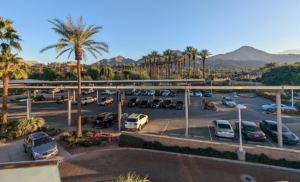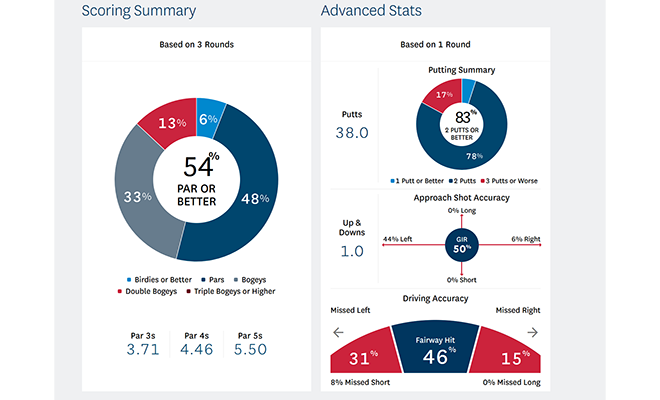Sun Spot: Indian Wells Golf Resort Goes Solar

When General Manager Sven Wiedenhaupt saw the plans for a solar panel structure that was slated to be installed on the driving range at Indian Wells Golf Resort, he recognized an opportunity. Not just to lower electricity costs, but also to inject new life into a space more known for function than style.
“What we’ve done is converted the necessary device to save energy into an architectural structure that is going to look like it belongs here,” said Wiedenhaupt. “We’ve taken the synergy of solar and turned it into an experience for golfers, businesspeople and families in the evening.”
The new range experience includes grass tees and 17 hitting bays shaded by the structure. During the day, golfers can take advantage of Toptracer technology, which provides detailed statistics about each shot, already installed on the range. At sunset, the area becomes a “Shots in the Night” amenity, with a variety of lit targets out on the range. At that time, bays can be rented for $65 per hour, with a seating area in each bay and food/drink options available as well.
Future plans include enclosing each bay to enhance privacy and potentially create a meeting space. The new power source is part of an energy efficiency project that the City of Indian Wells has implemented, one that includes additional solar panels in the resort’s parking lots and course maintenance area, upgraded HVAC units, lighting retrofits, lithium batteries in golf carts and reusable souvenir cups.
But it’s the new solar panel structure, which measures 200 feet long, 45 feet wide and 20 feet high, that will garner the most attention. According to Indian Wells City Manager Chris Freeland, the overall solar panel system is expected to generate 80 to 90 percent of the energy used by the entire golf resort, including the main clubhouse, pump system and maintenance yard (where separate solar panels will be installed in the next phase of the project).
The entire project is expected to produce 2.3 million kilowatt hours a year and remove the equivalent of approximately 2.1 million pounds of CO2 from the environment. “That’s important to us because energy prices continue to climb, but what we’re also trying to do is be a good steward of greenhouse gases and energy,” said Freeland.
The facility, which hosts a total of 70,000 rounds annually on its Celebrity and Players courses, is heavily used for special events like weddings and golf banquets, so with California’s rolling brownouts, losing power in the middle of an event would pose serious challenges.
“The backup battery system will help supply power when needed,” said Freeland. “Also, the clubhouse is a cooling center in Indian Wells (with a population of 5,000, it’s the smallest of nine cities in greater Palm Springs), so if the power does go out at some of our senior housing projects, those residents can come here and feel comfortable.”
TIP OF THE ICEBERG
The solar panel system will enable the resort to only pay low off-peak rates, and the minute it gets into higher-rate periods, the main battery (which measures 26 feet by 15 feet) containing the solar power will kick in and deliver the electricity. “It’s a very large energizer bunny,” said Wiedenhaupt. “On an annualized basis, it could be as much as $500,000 in savings, which we hope to reinvest back into the property.”
Solar panels are also being installed in the course maintenance yard in anticipation of a potential future requirement that anything under 2.5 horsepower will need to shift to electric power, and that the resort will probably need to recharge maintenance vehicles at some point.
“Ultimately, I think the writing is on the wall,” Wiedenhaupt said. “If Mercedes and Toyota are going electric, then inherently, Toro and John Deere are going to have to do the same.”
Despite the aforementioned changes, Wiedenhaupt thinks the golf industry is still at the tip of the iceberg when it comes to sustainability.
“We’ve had a very interesting shift in demographics,” he said. “Our golfers range in age from roughly 30 to 50, with some exceptions. They’re aware of sustainability. A lot of them have children, and they’re still young enough to know that if we don’t get it right now, then their future as senior citizens is at risk. I think there is general acceptance to sustainability. It’s no longer a dirty word. Going green used to be really shunned.”
Another positive, according to Wiedenhaupt, is that none of the ongoing sustainability efforts at Indian Wells GR are negatively impacting the golf experience.
“On the contrary, I think we’re almost enhancing that with new golf carts, nicer drink cups and shaded parking lots,” he said. “It’s not a threat to be sustainable. It’s a necessary change and evolution that we need. Kicking or screaming, I have a feeling it’s going to happen. I think we’re at that pivot point.”














